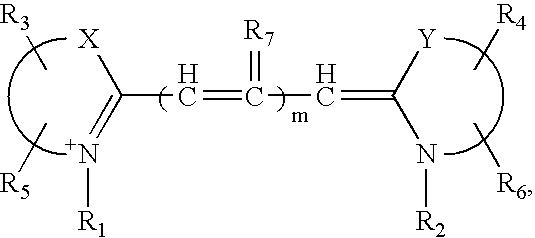Dideoxy dye terminators
a technology of dye terminators and dyes, applied in the field of dye terminators, can solve the problems of dye-induced compression artifacts, sequence ambiguities or errors known as “compressions”, and the intensity of band bands can vary by as much as 20-, so as to eliminate dye-induced compression artifacts and improve uniformity
- Summary
- Abstract
- Description
- Claims
- Application Information
AI Technical Summary
Benefits of technology
Problems solved by technology
Method used
Image
Examples
example 1
Synthesis of Dideoxy Dye Terminators Cy 5.5 Dideoxynucleoside Triphosphates
[0053]Dye terminators labeled with Cy5.5 were prepared from propargylaminodideoxynucleotids (Prober, J. M., Trainor, G. L., Dam, R. J., Hobbs, F. W., Robertson, C. W., Zagursky, R. J., Cocuzza, A. J., Jensen, M. A. and Baumeister, K., Science 238:336-41 (1987); U.S. Pat. Nos. 5,242,796, 5,306,618, and 5,332,666) and “CyDye Fluorolink Cy5.5 mono reactive dye” product PA25501 (Amersham Life Science) to produce compounds II, III, IV, and V. In the case of ddG and ddA, the propargylaminonucleotide was directly reacted with the N-hydroxysuccinimidyl ester of the Cy5.5 dye. In the case of ddC and ddT, a longer linker was constructed by reacting the propargylaminonucleotide with the N-hydroxysuccinimidyl ester of N-trifluoroacetyl-6-aminocaproic acid followed by hydrolysis in aqueous ammonia of the trifluoroacetyl group. The resulting compound was then reacted with the N-hydroxysuccinimidyl ester of the Cy5.5 dye to...
example 2
Dye Terminator Cycle Sequencing
[0055]DNA cycle sequencing was carried out using Thermo Sequenase™ DNA polymerase (Amersham, Cleveland, Ohio) and Cy5.5 dideoxy dye terminators using the following cycle sequencing protocol:
1. A master mix was prepared consisting of the following:
[0056]
Template DNA5.0μl10X Reaction buffer (see below)3.5μlPrimer, 2 μM1.0μlPolymerase (see below)2μH2O 15.5μlTotal volume27.0μl
[0057]10× Reaction Buffer:
[0058]150 mM Tris HCL pH 9.5
[0059]35 mM MgCl2
[0060]Polymerase: Thermo Sequenase™ DNA polymerase, 10 U / μl, 0.0017U / μl, Thermoplasma acidophilum inorganic pyrophosphatase: 20mM Tris-HCl, pH 8.5, 1 mM DTT, 0.1 mM EDTA, 0.5% Tween-20, 0.5% Nonidet P-40 and 50% glycerol.
2. Four microcentrifuge tubes were labeled and 2 μl of Cy5.5 labeled ddG, ddA, ddT, ddC solution was added to each tube.
[0061]25:1 ddG Mix, 300 μM each of dGTP, dATP, dTTP & dCTP, 12 μM Cy5.5 ddGTP[0062]25:1 ddA Mix, 300 μM each of dGTP, dATP, dTTP & dCTP, 12 μM Cy5.5 ddATP[0063]25:1 ddT Mix, 300...
example 3
Correlation of Linker Length and Band Intensity Variability
[0066]Sequencing reactions were carried out as described in example 2 with various dye molecules linked to dideoxynucleotides with linkers of various lengths (see Table 1). The labeled DNA products were then separated on denaturing polyacrylamide gels and the labeled products were detected by fluorescence. The intensity of the bands is taken as the height of the peaks in a graph of fluorescence (in arbitrary units) against time. Typically, systematic variations in peak heights can be seen in graphs of peak heights plotted sequentially. These systematic variations in the peak heights can be modeled by least-square fitting to a second-order polynominal function. Dividing the peak height for each band by the value of the curve-fit polynomial function yields a normalized band intensity for each peak. Variation in these band intensities can be expressed as the square root of the variance √{square root over ((nΣx2−(Σx)2 / n2))} of t...
PUM
| Property | Measurement | Unit |
|---|---|---|
| volume | aaaaa | aaaaa |
| temperature | aaaaa | aaaaa |
| volume | aaaaa | aaaaa |
Abstract
Description
Claims
Application Information
 Login to View More
Login to View More - R&D Engineer
- R&D Manager
- IP Professional
- Industry Leading Data Capabilities
- Powerful AI technology
- Patent DNA Extraction
Browse by: Latest US Patents, China's latest patents, Technical Efficacy Thesaurus, Application Domain, Technology Topic, Popular Technical Reports.
© 2024 PatSnap. All rights reserved.Legal|Privacy policy|Modern Slavery Act Transparency Statement|Sitemap|About US| Contact US: help@patsnap.com










